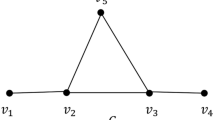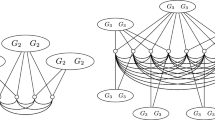Abstract
For directed and undirected graphs, we study how to make a distinguished vertex the unique minimum-(in)degree vertex through deletion of a minimum number of vertices. The corresponding NP-hard optimization problems are motivated by applications concerning control in elections and social network analysis. Continuing previous work for the directed case, we show that the problem is W[2]-hard when parameterized by the graph’s feedback arc set number, whereas it becomes fixed-parameter tractable when combining the parameters “feedback vertex set number” and “number of vertices to delete”. For the so far unstudied undirected case, we show that the problem is NP-hard and W[1]-hard when parameterized by the “number of vertices to delete”. On the positive side, we show fixed-parameter tractability for several parameterizations measuring tree-likeness. In particular, we provide a dynamic programming algorithm for graphs of bounded treewidth and a vertex-linear problem kernel with respect to the parameter “feedback edge set number”. On the contrary, we show a non-existence result concerning polynomial-size problem kernels for the combined parameter “vertex cover number and number of vertices to delete”, implying corresponding non-existence results when replacing vertex cover number by treewidth or feedback vertex set number.






Similar content being viewed by others
Notes
Observation 1 does not hold for a feedback vertex set containing the distinguished vertex. Hence, the following approach does not transfer to this more general case.
References
Bafna, V., Berman, P., Fujito, T.: A 2-approximation algorithm for the undirected feedback vertex set problem. SIAM J. Discrete Math. 12(3), 289–297 (1999)
Balasundaram, B., Butenko, S., Hicks, I.V.: Clique relaxations in social network analysis: the maximum k-plex problem. Oper. Res. 59(1), 133–142 (2011)
Bar-Yehuda, R., Geiger, D.: Approximation algorithms for the feedback vertex set problem with applications to constraint satisfaction and Bayesian inference. SIAM J. Comput. 27, 942–959 (1998)
Becker, A., Geiger, D.: Optimization of pearl’s method of conditioning and greedy-like approximation algorithms for the vertex feedback set problem. Artif. Intell. 83, 167–188 (1996)
Betzler, N., Bredereck, R., Niedermeier, R., Uhlmann, J.: On bounded-degree vertex deletion parameterized by treewidth. Discrete Appl. Math. 160(1–2), 53–60 (2012)
Betzler, N., Uhlmann, J.: Parameterized complexity of candidate control in elections and related digraph problems. Theor. Comput. Sci. 410(52), 5425–5442 (2009)
Bodlaender, H., Downey, R., Fellows, M.R., Hermelin, D.: On problems without polynomial kernels. J. Comput. Syst. Sci. 75(8), 423–434 (2009)
Bodlaender, H.L.: A linear time algorithm for finding tree-decompositions of small treewidth. SIAM J. Comput. 25, 1305–1317 (1996)
Bodlaender, H.L.: A partial k-arboretum of graphs with bounded treewidth. Theor. Comput. Sci. 209(1–2), 1–45 (1998)
Bodlaender, H.L.: Kernelization: new upper and lower bound techniques. In: Proceedings of the 4th International Workshop on Parameterized and Exact Computation (IWPEC’09). Lecture Notes in Computer Science, vol. 5917, pp. 17–37. Springer, Berlin (2009)
Bodlaender, H.L., Koster, A.M.C.A.: Treewidth computations II. Lower bounds. Inf. Comput. 209(7), 1103–1119 (2011)
Bodlaender, H.L., Thomassé, S., Yeo, A.: Kernel bounds for disjoint cycles and disjoint paths. Theor. Comput. Sci. 412(35), 4570–4578 (2011)
Cao, Y., Chen, J., Liu, Y.: On feedback vertex set new measure and new structures. In: Proceedings of the 12th Scandinavian Symposium and Workshops on Algorithm Theory (SWAT’10). Lecture Notes in Computer Science, vol. 6139, pp. 93–104. Springer, Berlin (2010)
Dom, M., Lokshtanov, D., Saurabh, S.: Incompressibility through colors and IDs. In: Proceedings of the 36th International Colloquium on Automata, Languages, and Programming (ICALP’09). Lecture Notes in Computer Science, vol. 5555, pp. 378–389. Springer, Berlin (2009)
Downey, R.G., Fellows, M.R.: Parameterized Complexity. Springer, Berlin (1999)
Faliszewski, P., Hemaspaandra, E., Hemaspaandra, L.A., Rothe, J.: Llull and Copeland voting computationally resist bribery and constructive control. Artif. Intell. 35(1), 275–341 (2009)
Fellows, M.: Towards fully multivariate algorithmics: some new results and directions in parameter ecology. In: Proceedings of the 20th International Workshop (IWOCA’09). Lecture Notes in Computer Science, vol. 5874, pp. 2–10. Springer, Berlin (2009)
Fellows, M.R., Guo, J., Moser, H., Niedermeier, R.: A generalization of Nemhauser and Trotter’s local optimization theorem. J. Comput. Syst. Sci. 77(6), 1141–1158 (2011)
Flum, J., Grohe, M.: Parameterized Complexity Theory. Springer, Berlin (2006)
Fortnow, L., Santhanam, R.: Infeasibility of instance compression and succinct PCPs for NP. J. Comput. Syst. Sci. 77(1), 91–106 (2011)
Garey, M.R., Johnson, D.S.: Computers and Intractability: A Guide to the Theory of NP-Completeness. Freeman, New York (1979)
Guo, J., Niedermeier, R.: Invitation to data reduction and problem kernelization. SIGACT News 38(1), 31–45 (2007)
Huberman, B.A., Romero, D.M., Wu, F.: Social networks that matter: twitter under the microscope. First Monday 14(1) (2009)
Kloks, T.: Treewidth. Computations and Approximations. Lecture Notes in Computer Science, vol. 842. Springer, Berlin (1994)
Komusiewicz, C., Niedermeier, R.: New races in parameterized algorithmics. In: Proceedings of the 37th International Symposium on Mathematical Foundations of Computer Science (MFCS’12). Lecture Notes in Computer Science, vol. 7464, pp. 19–30. Springer, Berlin (2012)
Lokshtanov, D., Misra, N., Saurabh, S.: Kernelization—preprocessing with a guarantee. In: The Multivariate Algorithmic Revolution and Beyond—Essays Dedicated to Michael R. Fellows on the Occasion of His 60th Birthday. Lecture Notes in Computer Science, vol. 7370, pp. 129–161. Springer, Berlin (2012)
Moser, H., Niedermeier, R., Sorge, M.: Exact combinatorial algorithms and experiments for finding maximum k-plexes. J. Comb. Optim. 24(3), 343–373 (2012)
Niedermeier, R.: Invitation to Fixed-Parameter Algorithms. Oxford University Press, Oxford (2006)
Niedermeier, R.: Reflections on multivariate algorithmics and problem parameterization. In: Proceedings of the 27th International Symposium on Theoretical Aspects of Computer Science (STACS’10), Leibniz International Proceedings in Informatics, vol. 5, pp. 17–32. Schloss Dagstuhl—Leibniz-Zentrum fuer Informatik, Wadern (2010)
Potterat, J., Phillips-Plummer, L., Muth, S., Rothenberg, R., Woodhouse, D., Maldonado-Long, T., Zimmerman, H., Muth, J.: Risk network structure in the early epidemic phase of HIV transmission in Colorado Springs. Sex. Transm. Infect. 78(Supplement 1), 159–163 (2002)
Ramachandramurthi, S.: The structure and number of obstructions to treewidth. SIAM J. Discrete Math. 10, 146–157 (1997)
Romm-Livermore, C., Setzekorn, K.: Social networking communities and e-dating services: concepts and implications. Information Science Reference (2008)
Seidman, S., Foster, B.: A graph-theoretic generalization of the clique concept. J. Math. Sociol. 6(1), 139–154 (1978)
Thomassé, S.: A 4k 2 kernel for feedback vertex set. ACM Trans. Algorithms 6(2), 32:1–32:8 (2010)
Wasserman, S., Faust, K.: Social Network Analysis: Methods and Applications. Cambridge University Press, Cambridge (1994)
Acknowledgement
We are grateful to two anonymous referees of Algorithmica whose constructive feedback helped to improve the quality of our presentation.
Author information
Authors and Affiliations
Corresponding author
Additional information
An extended abstract of this paper appeared in Proceedings of the 37th International Conference on Current Trends in Theory and Practice of Computer Science (SOFSEM-2011), January 22–28, 2011, Nový Smokovec, Slovakia, volume 6543 in Lecture Notes in Computer Science, pages 123–134, Springer, 2011. Compared to the conference version, the most important change (besides providing missing details) here is that we provide a concrete tree decomposition-based dynamic programming algorithm for Min-Degree Deletion parameterized by treewidth while the conference version just claimed a classification result based on monadic second-order logic.
N. Betzler and R. Bredereck were supported by the DFG, research project PAWS, NI 369/10.
J. Uhlmann was supported by the DFG, research project PABI, NI 369/7.
Rights and permissions
About this article
Cite this article
Betzler, N., Bodlaender, H.L., Bredereck, R. et al. On Making a Distinguished Vertex of Minimum Degree by Vertex Deletion. Algorithmica 68, 715–738 (2014). https://doi.org/10.1007/s00453-012-9695-6
Received:
Accepted:
Published:
Issue Date:
DOI: https://doi.org/10.1007/s00453-012-9695-6




